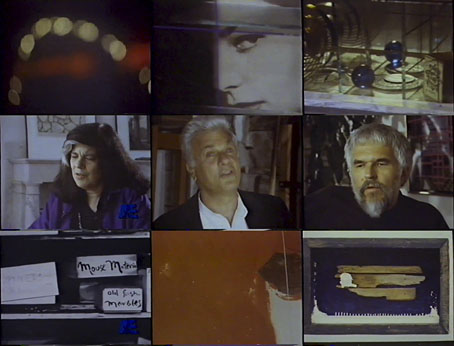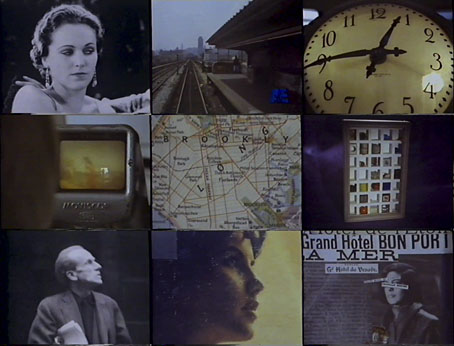Susan Sontag, Tony Curtis and Stan Brakhage all shared an appreciation for the work of American artist Joseph Cornell (1903–1972), and all appear in a 51-minute documentary Joseph Cornell: Worlds in a Box directed by Mark Stokes for the BBC in 1991. Susan Sontag was also the subject of one of Cornell’s collages, something she discusses here. Tony Curtis collected many of Cornell’s boxes and used to visit the artist when he was in New York; in Stokes’s film he discusses their relationship and reads from Cornell’s writings.
I’ve had a tape of this for years courtesy of Kerri Sharp who worked on the film (hi Kerri!) but it’s taken a while to turn up on YouTube. The value of films such as this isn’t so much the view they give of the works themselves—all of which are better judged in books or museums—but the way they function as mini-biographies which give a sense of the environment from which the art emerged. You can read in detail about Cornell’s life in Deborah Solomon’s Utopia Parkway: The Life and Work of Joseph Cornell (1997) but a text description of his home lacks the immediacy of the views Stokes gives us of the Cornell house, and the room where he created so much of his work. The film also follows Cornell’s train journeys into New York City, and visits the locations of his short films. Extracts of the latter appear throughout the documentary but you can see them in full at Ubuweb.
If you’re looking for an arty (and costly) Christmas present this year, Thames & Hudson have just published Joseph Cornell’s Manual of Marvels: How Joseph Cornell reinvented a French Agricultural Manual to create an American Masterpiece; two books in a box with a CD, edited by Analisa Leppanen-Guerra and Dickran Tashjian. The NYT reviews it here.
Previously on { feuilleton }
• Joseph Cornell, 1967
• Rose Hobart by Joseph Cornell
• View: The Modern Magazine



Like Max Ernst with his engravings collages, Cornell formed an immediately recognizable style that can be repeated ad nauseam by hacks. I feel I have to wipe my eyes of dozens of derivative book covers and magazine illustrations whenever approaching the original works of the master.
That’s an inevitable syndrome in any form of art when someone pushes things in a new direction. I never consider imitation a bad thing per se, art often develops by making small variations on what’s gone before until a breakthrough is achieved. Both Ernst and Cornell were using collage (Cornell’s boxes are essentially 3D collages), a technique which neither of them invented; if someone had forbidden them from copying earlier collagists we’d never have seen their own innovations.
Karenlee Grant’s Clockwork Orange album cover is one Cornell imitation I especially like:
http://www.johncoulthart.com/feuilleton/wp-content/uploads/2008/07/aco_sleeve-big.jpg
What a great find! “Joseph, honey, Andy Warhol, Charles Henri Ford, Robert Indiana and James Rosenquist are here to see you…”
I didn’t see any reference to this material at your site, so… For those of us who cannot get enough of Mr. Cornell there are the Joseph Cornell Papers at the Smithsonian Archives of American Art.
One comes away with an almost embarrassing feeling of having caught the man in his daily activities, and can see that like most things the mundane life formed the crux of his art…
http://www.aaa.si.edu/collections/joseph-cornell-papers-5790/more
John: Thanks, I’d not seen that before. Not sure I need anything at that level of detail (!) but it’s good to know it’s there.
I have this on video too, didn’t realize it was as long ago as 1991 !
Tony Curtis did collect Cornell’s work but he also made his own pastiche Cornell style boxes, which in fact annoyed Cornell.
Nice to see this on YouTube though, as of course it will never be released on DVD..
I have a question for Kerri Sharp. The film shows film footage that purports to be of Joyce Hunter, but it’s of a different woman than the photograph used on Joyce Hunter’s findagrave.com site. Just wondering what the source was for thinking that woman in the film was Joyce Hunter.